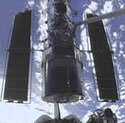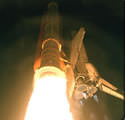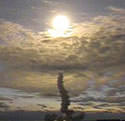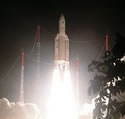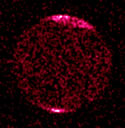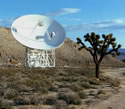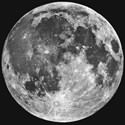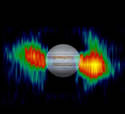
Image credit: NASA
Scientists have uncovered the workings of an invisible bubble of charged particles that surround Jupiter and interact with the solar wind. This bubble is called the magnetosphere and extends to a distance of 100 times the diameter of Jupiter itself. 14 months ago, two spacecraft: Galileo and Cassini took simultaneous readings of the giant planet’s magnetosphere from different vantage points. Detailed results of their findings will be published in scientific journals in the next few days.
Scientists simultaneously using a combination of NASA spacecraft have seen into the workings of an invisible whirling bubble of charged particles surrounding Jupiter.
That bubble, Jupiter’s magnetosphere, is the biggest object with distinct boundaries within our solar system, more than 100 times wider than Jupiter itself. It contracts in response to shock waves from the Sun, according to one report appearing in the journal Nature tomorrow. In all, seven reports appearing together will detail various results from a concerted research campaign that took advantage of the Saturn-bound Cassini spacecraft’s flyby of Jupiter 14 months ago.
The campaign found extremely energetic electrons traveling near the speed of light close to Jupiter, as well as a vast nebula of neutral atoms, and triggers for glowing auroras near Jupiter’s north and south poles.
“We’re seeing results from a remarkable opportunity,” said Dr. Scott Bolton, a physicist at NASA’s Jet Propulsion Laboratory, Pasadena, Calif., and a co-author of three of the reports.
“We had one spacecraft, Galileo, inside the magnetosphere monitoring what was happening there at the same time another spacecraft, Cassini, was outside the magnetosphere monitoring the solar wind just upstream,” Bolton said. The solar wind is particles from the Sun flowing outward through the solar system. Jupiter’s magnetosphere, like Earth’s, deflects the solar wind but gets pushed around by its gusts.
On Jan. 10, 2001, when Cassini and Galileo were more than 20 times farther from each other than Earth is from the Moon, each spacecraft encountered the boundary of Jupiter’s magnetosphere while the bubble was contracting in response to an increase in solar-wind pressure.
“This is the first two-point measurement of the Jovian system actually responding to the solar wind,” said Dr. William Kurth, physicist at the University of Iowa, Iowa City, and lead author of the Nature report on these results. “The combined observations of Galileo and Cassini help show us the relative importance of the influence of the solar wind and the factors affecting the magnetosphere from within — primarily the energy from Jupiter’s rotation and the supply of material from volcanoes on the moon Io.” The Jupiter observations strengthen confidence in our understanding about Earth’s protective magnetosphere.
Shock waves from outbursts on the Sun, carried outward on the solar wind and detected by Cassini, also stimulated radio emissions from deep within Jupiter’s magnetosphere and brightened auroras at Jupiter’s poles, Dr. Donald Gurnett of the University of Iowa reports. Those effects suggest that electron density and electric currents in the magnetosphere increase when it is compacted by the shock wave.
Besides Galileo, which has been orbiting Jupiter since 1995, and Cassini, scientists used two Earth orbiters — the Hubble Space Telescope and Chandra X-ray Observatory ? plus radio telescopes in New Mexico and Arizona to examine Jupiter’s surroundings while Cassini was there.
Hubble images show patches of Jupiter’s aurora stimulated by an event Galileo detected within the magnetosphere, reports Dr. Barry Mauk of Johns Hopkins University’s Applied Physics Laboratory, Laurel, Md. The event is a surge of charged particles toward the planet, apparently analogous to similar aurora-triggering surges that release pent-up energy in Earth’s magnetosphere. Some other features in Jupiter’s aurora are “footprints” of currents flowing through the magnetosphere from three of the planet’s large moons, reports Dr. John Clarke of Boston University. Dr. Randall Gladstone of the Southwest Research Institute, San Antonio, Texas, describes a 45-minute rhythm in auroras at X-ray wavelengths, likely linked to a still-unidentified stimulus in the outer portion of the magnetosphere.
Cassini carries a type of magnetosphere-imaging instrument no previous interplanetary spacecraft has had. The instrument not only showed some structural detail of Jupiter’s magnetosphere, it also detected a cloud of neutral atoms stretching away from the planet as a “hot neutral wind,” reports Dr. Stamatios Krimigis of Hopkins’ Applied Physics Laboratory. The magnetic field holds charged particles in, but neutral ones escape to create a nebula of particles that extends beyond the magnetosphere.
High-energy electrons in radiation belts close to Jupiter emit radio waves that have been monitored from Earth for years. JPL’s Bolton and other scientists used Cassini while it was near Jupiter to map details never seen before in those belts. About 2,300 students at high schools and middle schools across the country participated in a program of radio-telescope observations that aided interpretation of those Cassini observations.
Cassini is a cooperative project of NASA, the European Space Agency and the Italian Space Agency. JPL manages Cassini and Galileo for NASA?s Office of Space Science, Washington, D.C. JPL is a division of the California Institute of Technology in Pasadena.
Original Source: NASA/JPL News Release
